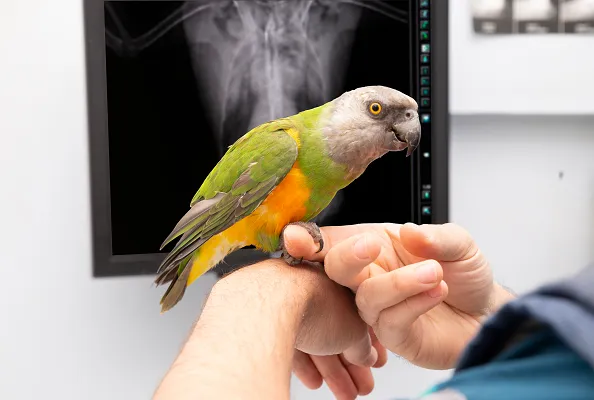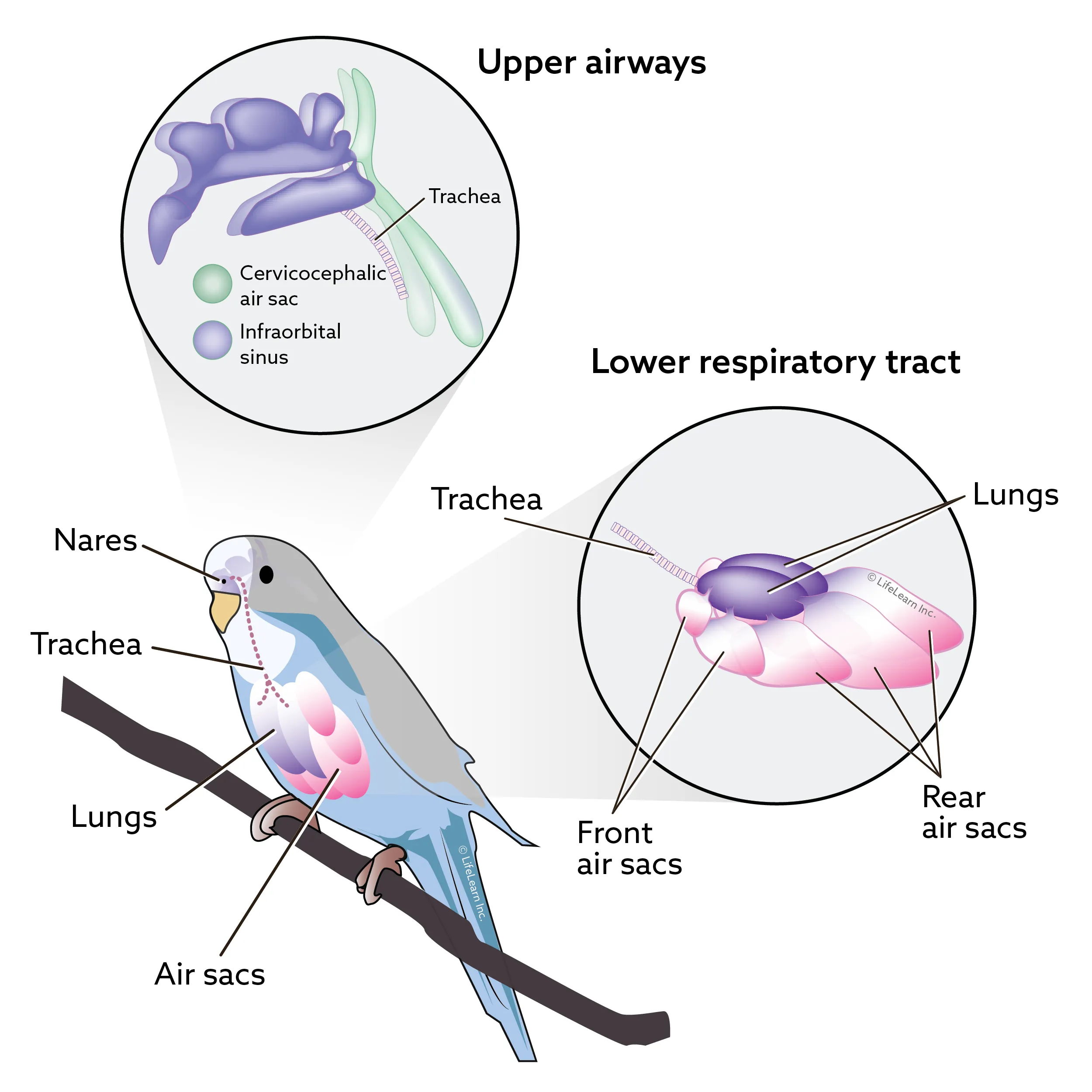Respiratory diseases are among the most common health issues affecting pet birds of all species. These conditions can stem from various causes, making early diagnosis and prompt treatment essential to avoid severe, potentially fatal complications. If you’re a bird owner noticing changes in your pet’s breathing or behavior, understanding the signs and seeking avian veterinary care can make all the difference. For more on parrot health care, check out our detailed guide.
Common Causes of Respiratory Problems in Pet Birds
Respiratory issues in pet birds often arise from dietary deficiencies, infections, or environmental factors. A diet heavy in seeds is a frequent culprit, as most seeds lack sufficient vitamin A, crucial for maintaining healthy epithelial cells lining the respiratory tract. Without adequate vitamin A, these cells become vulnerable to invasion by bacteria and other pathogens.
 Bird at vet exam for respiratory issues
Bird at vet exam for respiratory issues
Infections can be triggered by parasites, fungi like Aspergillus, viruses, Mycoplasma bacteria, or Chlamydia—the organism behind parrot fever (psittacosis). Organ enlargement from tumors or infections can compress the airways, leading to breathing difficulties. Environmental irritants, such as cigarette smoke, oil-based paints, or aerosol sprays, may also provoke sneezing or wheezing.
A critical warning for bird owners: Avoid non-stick cookware with polytetrafluoroethylene (PTFE), like Teflon pans. When overheated above 536°F (280°C), it releases toxic fumes that can cause sudden death in birds. Similarly, keep Teflon-coated appliances like toaster ovens away from your feathered friends.
Species-Specific Risks and Myths
Certain respiratory causes are more prevalent in specific bird species, highlighting the need for an avian-specialized veterinarian. Budgerigars (budgies) and cockatiels can carry Mycoplasma or Chlamydia asymptomatically, spreading them to flock mates. Older seed-fed Amazon parrots often develop vitamin A deficiencies leading to bacterial sinusitis, while finches and canaries frequently battle air sac mites.
 Anatomy of bird respiratory system showing upper and lower tracts
Anatomy of bird respiratory system showing upper and lower tracts
Contrary to popular belief, drafts do not cause colds in birds. Birds tolerate temperature fluctuations well, but constant direct airflow from vents—too hot or cold—stresses their immune system, potentially increasing infection susceptibility. Rapid shifts between extremes can weaken defenses, but drafts alone won’t trigger respiratory disease.
For budgie owners dealing with cold-like symptoms, explore options like budgie medicine for cold after consulting a vet.
Recognizing Signs of Respiratory Distress
Symptoms vary by infection location in the upper (nasal passages, sinuses, trachea) or lower (lungs, air sacs) respiratory tract. Tracheal infections might only alter voice or cause open-mouth breathing due to mucus or pus blockages. Lung or air sac involvement leads to labored breathing, often with tail bobbing.
Other indicators include watery eyes, sneezing, wheezing, coughing, nasal discharge, ruffled feathers, lethargy, or closed eyes. Mild cases may lack obvious respiratory signs, but any of these warrant immediate veterinary attention to prevent escalation.
Accurate Diagnosis by an Avian Veterinarian
 Veterinarian examining pet bird for respiratory disease
Veterinarian examining pet bird for respiratory disease
Diagnosis starts with a detailed history and physical exam. Stabilizing critically ill birds in an oxygen cage may precede further tests. Bloodwork assesses cell counts and organ function, while radiographs evaluate lungs and air sacs.
For upper respiratory signs, sinus aspirates or nasal flushes allow culturing for bacteria or fungi. Lower tract issues may require X-rays and targeted tests for Chlamydia or Aspergillus. Avian vets draw on expertise to pinpoint causes accurately.
Owners of species like sun conures should watch for related issues, such as sun conure eye infection, which can overlap with respiratory problems.
Why Avoid Over-the-Counter Treatments?
Pet store medications are inadequate for bird respiratory diseases—they’re too weak and delay proper care, often worsening outcomes. Antibiotics from these sources only target bacteria, ignoring fungal, viral, or parasitic causes. Self-treatment wastes time and money; always consult a bird-savvy vet for exams and tests.
For beak health tied to overall wellness, see our articles on healthy budgie beak and healthy parakeet beak.
Effective Treatment Strategies
Treatment hinges on diagnosis. Bacterial infections respond to antibiotics; fungal issues like aspergillosis need oral or nebulized antifungals; parasites require anti-parasitics. Dietary corrections and vitamin A supplements address deficiencies gradually.
Hospitalization aids severe cases with nebulization, injectables, gavage feeding, or IV fluids. Early intervention boosts success rates, though advanced cases carry risks. As experienced bird caregivers know, proactive monitoring—from diet to environment—prevents many issues.
In summary, respiratory diseases in pet birds demand swift action: recognize signs, avoid toxins, and partner with an avian vet. Regular check-ups, balanced nutrition (pellets over seeds), and clean habitats keep your bird thriving. Consult your veterinarian at the first hint of trouble, and explore more pet bird care tips on our site for healthier companions.
References
- Association of Avian Veterinarians (AAV) guidelines on respiratory infections.
- Merck Veterinary Manual: Respiratory Diseases of Pet Birds.
- Studies on vitamin A deficiency in psittacines (e.g., Journal of Avian Medicine and Surgery).
